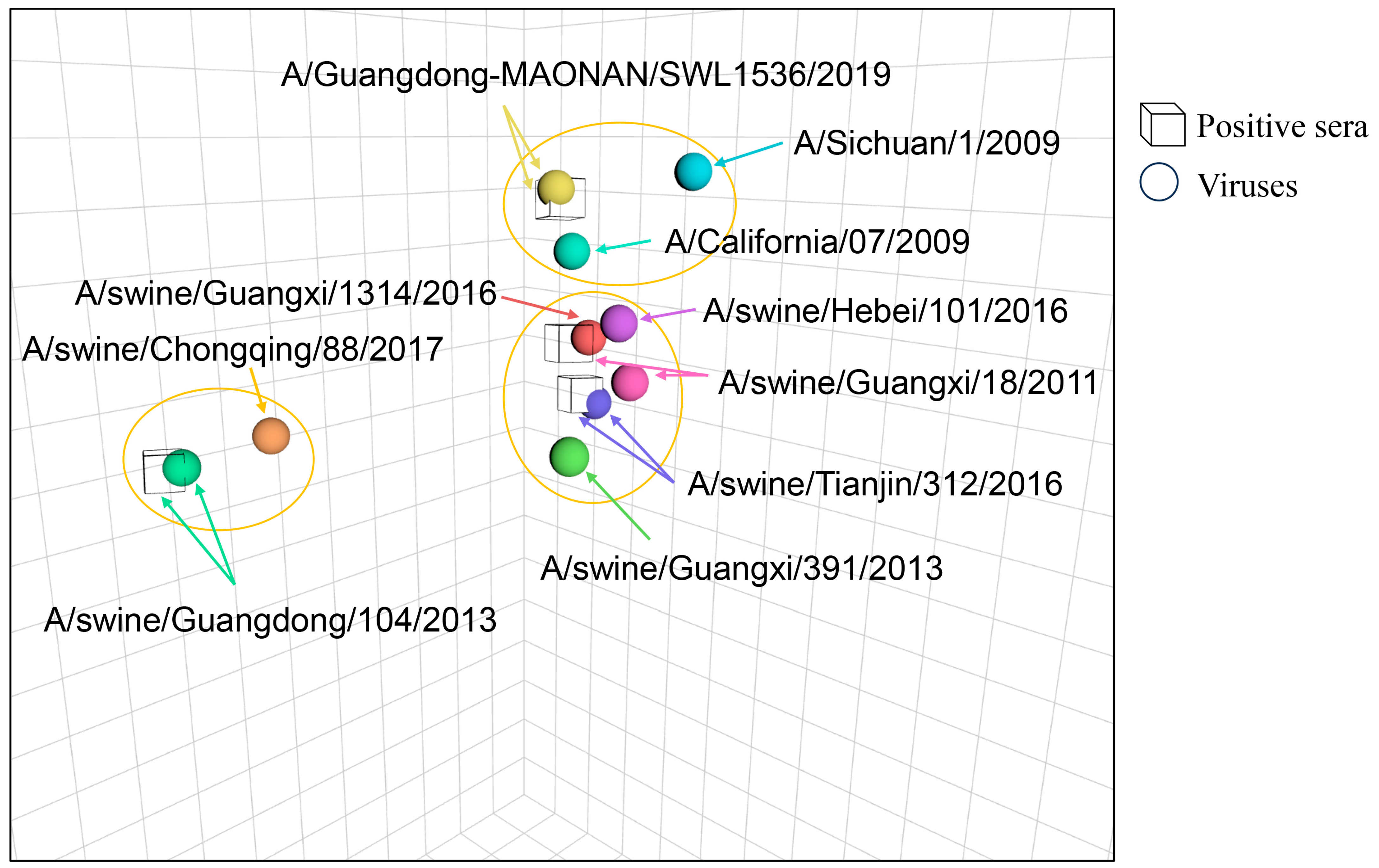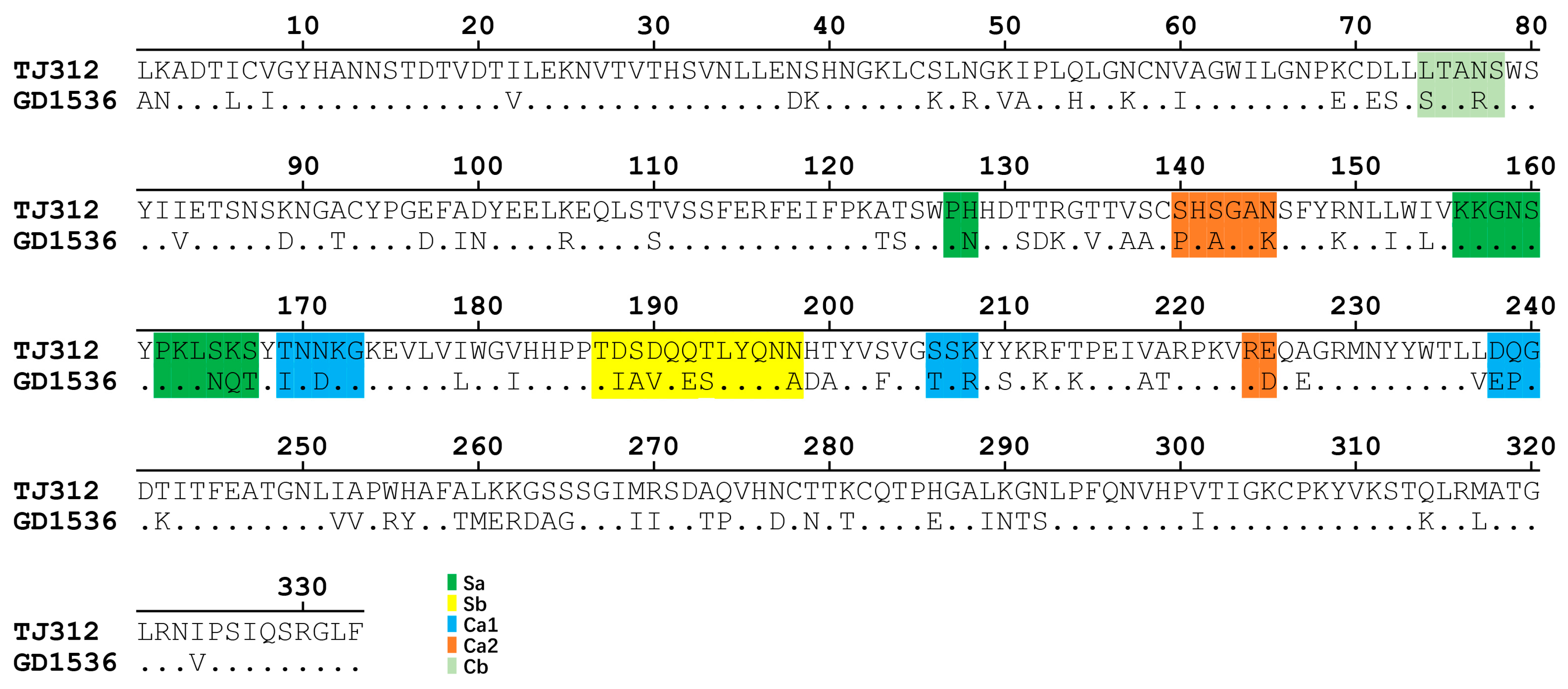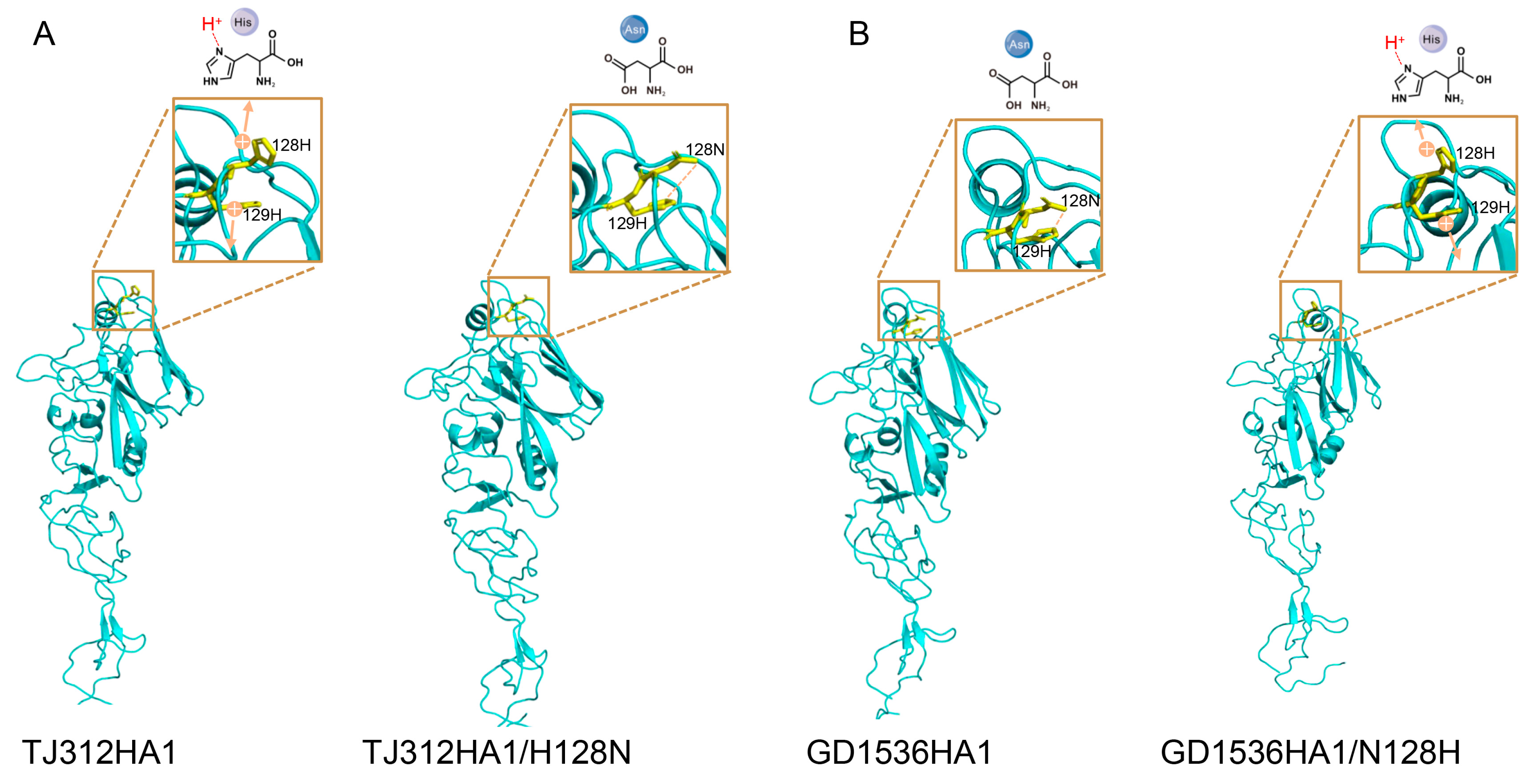H128N Substitution in the Sa Antigenic Site of HA1 Causes Antigenic Drift Between Eurasian Avian-like H1N1 and 2009 Pandemic H1N1 Influenza Viruses
Abstract
1. Introduction
2. Materials and Methods
2.1. Cells, Viruses, Sera, and Reagents
2.2. Antigenic Analysis
2.3. HA1 Protein Sequence Alignment and Analysis
2.4. Rescue and Antigenic Validation of Single-Site Mutant Viruses
2.5. Structural and Mutational Simulation Analysis of the HA1 128 Amino Acid Position
3. Results
3.1. HI Assays Reveal Significant Antigenic Differences Between TJ312 and GD1536
3.2. HA1 Protein Sequence Alignment Reveals Multiple Amino Acid Differences in Antigenic Sites
3.3. The Amino Acid at Position 128 in the HA1 Protein Is a Key Determinant of Antigenic Differences Between TJ312 and GD1536 Strains
3.4. Structural Analysis Reveals the Impact of the 128 Amino Acid Substitution on HA1 Conformation
4. Discussion
5. Conclusions
Supplementary Materials
Author Contributions
Funding
Informed Consent Statement
Data Availability Statement
Conflicts of Interest
References
- Henritzi, D.; Petric, P.P.; Lewis, N.S.; Graaf, A.; Pessia, A.; Starick, E.; Breithaupt, A.; Strebelow, G.; Luttermann, C.; Parker, L.M.K.; et al. Surveillance of European Domestic Pig Populations Identifies an Emerging Reservoir of Potentially Zoonotic Swine Influenza A Viruses. Cell Host Microbe 2020, 28, 614–627.e6. [Google Scholar] [CrossRef]
- Meng, F.; Chen, Y.; Song, Z.C.; Zhong, Q.; Zhang, Y.J.; Qiao, C.L.; Yan, C.; Kong, H.H.; Liu, L.L.; Li, C.J.; et al. Continued evolution of the Eurasian avian-like H1N1 swine influenza viruses in China. Sci. China-Life Sci. 2023, 66, 269–282. [Google Scholar] [CrossRef]
- Pensaert, M.; Ottis, K.; Vandeputte, J.; Kaplan, M.M.; Bachmann, P.A. Evidence for the natural transmission of influenza A virus from wild ducts to swine and its potential importance for man. Bull. World Health Organ. 1981, 59, 75–78. [Google Scholar]
- Yang, H.; Chen, Y.; Qiao, C.; He, X.; Zhou, H.; Sun, Y.; Yin, H.; Meng, S.; Liu, L.; Zhang, Q.; et al. Prevalence, genetics, and transmissibility in ferrets of Eurasian avian-like H1N1 swine influenza viruses. Proc. Natl. Acad. Sci. USA 2016, 113, 392–397. [Google Scholar] [CrossRef]
- Sun, H.; Xiao, Y.; Liu, J.; Wang, D.; Li, F.; Wang, C.; Li, C.; Zhu, J.; Song, J.; Sun, H.; et al. Prevalent Eurasian avian-like H1N1 swine influenza virus with 2009 pandemic viral genes facilitating human infection. Proc. Natl. Acad. Sci. USA 2020, 117, 17204–17210. [Google Scholar] [CrossRef]
- Durrwald, R.; Wedde, M.; Biere, B.; Oh, D.Y.; Hessler-Klee, M.; Geidel, C.; Volmer, R.; Hauri, A.M.; Gerst, K.; Thurmer, A.; et al. Zoonotic infection with swine A/H1(av)N1 influenza virus in a child, Germany, June 2020. Euro Surveill. Bull. Eur. Sur Les Mal. Transm. = Eur. Commun. Dis. Bull. 2020, 25, 2001638. [Google Scholar] [CrossRef]
- Eggink, D.; Kroneman, A.; Dingemans, J.; Goderski, G.; van den Brink, S.; Bagheri, M.; Lexmond, P.; Pronk, M.; van der Vries, E.; Germeraad, E.; et al. Human infections with Eurasian avian-like swine influenza virus detected by coincidence via routine respiratory surveillance systems, the Netherlands, 2020 to 2023. Euro Surveill. Bull. Eur. Sur Les Mal. Transm. = Eur. Commun. Dis. Bull. 2025, 30, 2400662. [Google Scholar] [CrossRef] [PubMed]
- He, F.; Yu, H.; Liu, L.; Li, X.; Xing, Y.; Yang, L.; Yang, P.; Zhu, L.; Li, Z. Antigenicity and genetic properties of an Eurasian avian-like H1N1 swine influenza virus in Jiangsu Province, China. Biosaf. Health 2024, 6, 319–326. [Google Scholar] [CrossRef] [PubMed]
- He, Y.; Song, S.; Wu, J.; Wu, J.; Zhang, L.; Sun, L.; Li, Z.; Wang, X.; Kou, Z.; Liu, T. Emergence of Eurasian Avian-Like Swine Influenza A (H1N1) virus in a child in Shandong Province, China. BMC Infect. Dis. 2024, 24, 550. [Google Scholar] [CrossRef] [PubMed]
- Li, X.; Guo, L.; Liu, C.; Cheng, Y.; Kong, M.; Yang, L.; Zhuang, Z.; Liu, J.; Zou, M.; Dong, X.; et al. Human infection with a novel reassortant Eurasian-avian lineage swine H1N1 virus in northern China. Emerg. Microbes Infect. 2019, 8, 1535–1545. [Google Scholar] [CrossRef]
- Parys, A.; Vandoorn, E.; King, J.; Graaf, A.; Pohlmann, A.; Beer, M.; Harder, T.; Van Reeth, K. Human Infection with Eurasian Avian-Like Swine Influenza A(H1N1) Virus, the Netherlands, September 2019. Emerg. Infect. Dis. 2021, 27, 939–943. [Google Scholar] [CrossRef]
- Wang, D.Y.; Qi, S.X.; Li, X.Y.; Guo, J.F.; Tan, M.J.; Han, G.Y.; Liu, Y.F.; Lan, Y.; Yang, L.; Huang, W.J.; et al. Human infection with Eurasian avian-like influenza A(H1N1) virus, China. Emerg. Infect. Dis. 2013, 19, 1709–1711. [Google Scholar] [CrossRef]
- Xie, J.F.; Zhang, Y.H.; Zhao, L.; Xiu, W.Q.; Chen, H.B.; Lin, Q.; Weng, Y.W.; Zheng, K.C. Emergence of Eurasian Avian-Like Swine Influenza A (H1N1) Virus from an Adult Case in Fujian Province, China. Virol. Sin. 2018, 33, 282–286. [Google Scholar] [CrossRef]
- Zhu, W.; Zhang, H.; Xiang, X.; Zhong, L.; Yang, L.; Guo, J.; Xie, Y.; Li, F.; Deng, Z.; Feng, H.; et al. Reassortant Eurasian Avian-Like Influenza A(H1N1) Virus from a Severely Ill Child, Hunan Province, China, 2015. Emerg. Infect. Dis. 2016, 22, 1930–1936. [Google Scholar] [CrossRef]
- Zhu, W.F.; Feng, Z.M.; Chen, Y.K.; Yang, L.; Liu, J.; Li, X.Y.; Liu, S.L.; Zhou, L.J.; Wei, H.J.; Gao, R.B.; et al. Mammalian-adaptive mutation NP-Q357K in Eurasian H1N1 Swine Influenza viruses determines the virulence phenotype in mice. Emerg. Microbes Infect. 2019, 8, 989–999. [Google Scholar] [CrossRef]
- Neumann, G.; Noda, T.; Kawaoka, Y. Emergence and pandemic potential of swine-origin H1N1 influenza virus. Nature 2009, 459, 931–939. [Google Scholar] [CrossRef] [PubMed]
- Smith, G.J.; Vijaykrishna, D.; Bahl, J.; Lycett, S.J.; Worobey, M.; Pybus, O.G.; Ma, S.K.; Cheung, C.L.; Raghwani, J.; Bhatt, S.; et al. Origins and evolutionary genomics of the 2009 swine-origin H1N1 influenza A epidemic. Nature 2009, 459, 1122–1125. [Google Scholar] [CrossRef]
- Anderson, T.K.; Macken, C.A.; Lewis, N.S.; Scheuermann, R.H.; Van Reeth, K.; Brown, I.H.; Swenson, S.L.; Simon, G.; Saito, T.; Berhane, Y.; et al. A Phylogeny-Based Global Nomenclature System and Automated Annotation Tool for H1 Hemagglutinin Genes from Swine Influenza A Viruses. mSphere 2016, 1, e00275-16. [Google Scholar] [CrossRef] [PubMed]
- Vijaykrishna, D.; Smith, G.J.; Pybus, O.G.; Zhu, H.; Bhatt, S.; Poon, L.L.; Riley, S.; Bahl, J.; Ma, S.K.; Cheung, C.L.; et al. Long-term evolution and transmission dynamics of swine influenza A virus. Nature 2011, 473, 519–522. [Google Scholar] [CrossRef] [PubMed]
- Kilbourne, E.D.; Smith, C.; Brett, I.; Pokorny, B.A.; Johansson, B.; Cox, N. The total influenza vaccine failure of 1947 revisited: Major intrasubtypic antigenic change can explain failure of vaccine in a post-World War II epidemic. Proc. Natl. Acad. Sci. USA 2002, 99, 10748–10752. [Google Scholar] [CrossRef]
- Schotsaert, M.; García-Sastre, A. A High-Resolution Look at Influenza Virus Antigenic Drift. J. Infect. Dis. 2016, 214, 982. [Google Scholar] [CrossRef]
- Smith, D.J.; Forrest, S.; Ackley, D.H.; Perelson, A.S. Variable efficacy of repeated annual influenza vaccination. Proc. Natl. Acad. Sci. USA 1999, 96, 14001–14006. [Google Scholar] [CrossRef]
- Meng, F.; Yang, H.; Qu, Z.; Chen, Y.; Zhang, Y.; Zhang, Y.; Liu, L.; Zeng, X.; Li, C.; Kawaoka, Y.; et al. A Eurasian avian-like H1N1 swine influenza reassortant virus became pathogenic and highly transmissible due to mutations in its PA gene. Proc. Natl. Acad. Sci. USA 2022, 119, e2203919119. [Google Scholar] [CrossRef]
- Wu, N.C.; Wilson, I.A. Influenza Hemagglutinin Structures and Antibody Recognition. Cold Spring Harb. Perspect. Med. 2020, 10, a038778. [Google Scholar] [CrossRef]
- Caton, A.J.; Brownlee, G.G.; Yewdell, J.W.; Gerhard, W. The antigenic structure of the influenza virus A/PR/8/34 hemagglutinin (H1 subtype). Cell 1982, 31, 417–427. [Google Scholar] [CrossRef] [PubMed]
- Gerhard, W.; Yewdell, J.; Frankel, M.E.; Webster, R. Antigenic structure of influenza virus haemagglutinin defined by hybridoma antibodies. Nature 1981, 290, 713–717. [Google Scholar] [CrossRef] [PubMed]
- Retamal, M.; Abed, Y.; Rheaume, C.; Baz, M.; Boivin, G. In vitro and in vivo evidence of a potential A(H1N1)pdm09 antigenic drift mediated by escape mutations in the haemagglutinin Sa antigenic site. J. Gen. Virol. 2017, 98, 1224–1231. [Google Scholar] [CrossRef] [PubMed]
- Stray, S.J.; Pittman, L.B. Subtype- and antigenic site-specific differences in biophysical influences on evolution of influenza virus hemagglutinin. Virol. J. 2012, 9, 91. [Google Scholar] [CrossRef]
- Xu, R.; Ekiert, D.C.; Krause, J.C.; Hai, R.; Crowe, J.E., Jr.; Wilson, I.A. Structural basis of preexisting immunity to the 2009 H1N1 pandemic influenza virus. Science 2010, 328, 357–360. [Google Scholar] [CrossRef]
- Shih, A.C.C.; Hsiao, T.C.; Ho, M.S.; Li, W.H. Simultaneous amino acid substitutions at antigenic sites drive influenza A hemagglutinin evolution. Proc. Natl. Acad. Sci. USA 2007, 104, 6283–6288. [Google Scholar] [CrossRef]
- van Diemen, P.M.; Byrne, A.M.P.; Ramsay, A.M.; Watson, S.; Nunez, A.; V Moreno, A.; Chiapponi, C.; Foni, E.; Brown, I.H.; Brookes, S.M.; et al. Interspecies Transmission of Swine Influenza A Viruses and Human Seasonal Vaccine-Mediated Protection Investigated in Ferret Model. Emerg. Infect. Dis. 2023, 29, 1798–1807. [Google Scholar] [CrossRef] [PubMed]
- Wang, Z.; Chen, Y.; Chen, H.; Meng, F.; Tao, S.; Ma, S.; Qiao, C.; Chen, H.; Yang, H. A single amino acid at position 158 in haemagglutinin affects the antigenic property of Eurasian avian-like H1N1 swine influenza viruses. Transbound. Emerg. Dis. 2022, 69, e236–e243. [Google Scholar] [CrossRef] [PubMed]
- Xu, C.; Zhang, N.; Yang, Y.; Liang, W.; Zhang, Y.; Wang, J.; Suzuki, Y.; Wu, Y.; Chen, Y.; Yang, H.; et al. Immune Escape Adaptive Mutations in Hemagglutinin Are Responsible for the Antigenic Drift of Eurasian Avian-Like H1N1 Swine Influenza Viruses. J. Virol. 2022, 96, e0097122. [Google Scholar] [CrossRef] [PubMed]





| Viruses | Virus Rescue | |
|---|---|---|
| Mutation of HA | Successfully Rescued | |
| TJ312/Mut-1 | I6L, V8I | Yes |
| TJ312/Mut-2 | I22V | Yes |
| TJ312/Mut-3 | N38D, S39K | Yes |
| TJ312/Mut-4 | S46K, N48R, K50V, I51A | Yes |
| TJ312/Mut-5 | Q54H | Yes |
| TJ312/Mut-6 | N57K | Yes |
| TJ312/Mut-7 | V60I | Yes |
| TJ312/Mut-8 | K69E, D71E, L72S, L74S, N77R | Yes |
| TJ312/Mut-9 | I83V | Yes |
| TJ312/Mut-10 | K89D | Yes |
| TJ312/Mut-11 | A92T | Yes |
| TJ312/Mut-12 | E97D, A99I, D100N | Yes |
| TJ312/Mut-13 | K105R | Yes |
| TJ312/Mut-14 | T110S | Yes |
| TJ312/Mut-15 | A123T, T124S | Yes |
| TJ312/Mut-16 | H128N | Yes |
| TJ312/Mut-17 | T131S, T132D, R133K | Yes |
| TJ312/Mut-18 | T135V, V137A, S138A, S140P, S142A | No a |
| TJ312/Mut-19 | N145K | Yes |
| TJ312/Mut-20 | R149K | Yes |
| TJ312/Mut-21 | L152I, I154L | Yes |
| TJ312/Mut-22 | S165N, K166Q, S167T, T169I, N171D | No |
| TJ312/Mut-23 | I179L | Yes |
| TJ312/Mut-24 | V182I | Yes |
| TJ312/Mut-25 | D188I, S189A, D190V, Q192E, T193S | Yes |
| TJ312/Mut-26 | N198A, H199D, T200A | Yes |
| TJ312/Mut-27 | S203F | Yes |
| TJ312/Mut-28 | S206T, K208R, Y210S, R212K, T214K | Yes |
| TJ312/Mut-29 | V218A, A219T | Yes |
| TJ312/Mut-30 | E225D, A227E | Yes |
| TJ312/Mut-31 | L237V, D237E, Q239P | Yes |
| TJ312/Mut-32 | T242K | Yes |
| TJ312/Mut-33 | I252V, A253V, W255R, H256Y | Yes |
| TJ312/Mut-34 | A259T, L260M, K261E, K262R, G263D, S264A S265G | Yes |
| TJ312/Mut-35 | M269I, R270I | Yes |
| TJ312/Mut-36 | A273T, Q274P | Yes |
| TJ312/Mut-37 | N277D, T279N, K281T | Yes |
| TJ312/Mut-38 | H286E | Yes |
| TJ312/Mut-39 | L289I, K290N, G291T, N292S | Yes |
| TJ312/Mut-40 | V301I | Yes |
| TJ312/Mut-41 | Q314K | Yes |
| TJ312/Mut-42 | M317L | Yes |
| TJ312/Mut-43 | I324V | Yes |
| Virus | Genetic Group | Ferret Antisera | |||
|---|---|---|---|---|---|
| TJ312 | GD1536 | GD104 | GX18 | ||
| TJ312 | EA1 | 640 a | 80 | 20 | 640 |
| GD1536 | 2009/H1N1 | 40 | 1280 | 20 | 320 |
| GD104 | EA2 | <20 b | <20 | 1280 | 20 |
| GX18 | EA1 | 160 | 160 | 20 | 640 |
| Virus | Ferret Antisera | Virus | Ferret Antisera | ||
|---|---|---|---|---|---|
| TJ312 | GD1536 | TJ312 | GD1536 | ||
| TJ312 | 640 a | 80 | TJ312/Mut-21 | 640 | 80 |
| GD1536 | 40 | 1280 | TJ312/Mut-22 | - | - |
| chimeric G-T | 40 | 1280 | TJ312/Mut-23 | 640 | 40 |
| chimeric T-G | 640 | 80 | TJ312/Mut-24 | 640 | 80 |
| TJ312/Mut-1 | 640 | 80 | TJ312/Mut-25 | 160 | 20 |
| TJ312/Mut-2 | 640 | 40 | TJ312/Mut-26 | 640 | 80 |
| TJ312/Mut-3 | 640 | 80 | TJ312/Mut-27 | 640 | 160 |
| TJ312/Mut-4 | 640 | 80 | TJ312/Mut-28 | 640 | 80 |
| TJ312/Mut-5 | 640 | 80 | TJ312/Mut-29 | 640 | 40 |
| TJ312/Mut-6 | 640 | 80 | TJ312/Mut-30 | 320 | 80 |
| TJ312/Mut-7 | 640 | 80 | TJ312/Mut-31 | 640 | 80 |
| TJ312/Mut-8 | 640 | 80 | TJ312/Mut-32 | 640 | 80 |
| TJ312/Mut-9 | 640 | 80 | TJ312/Mut-33 | 640 | 80 |
| TJ312/Mut-10 | 640 | 80 | TJ312/Mut-34 | 640 | 40 |
| TJ312/Mut-11 | 640 | 80 | TJ312/Mut-35 | 640 | 80 |
| TJ312/Mut-12 | 640 | 80 | TJ312/Mut-36 | 640 | 80 |
| TJ312/Mut-13 | 640 | 80 | TJ312/Mut-37 | 640 | 40 |
| TJ312/Mut-14 | 640 | 80 | TJ312/Mut-38 | 640 | 80 |
| TJ312/Mut-15 | 640 | 80 | TJ312/Mut-39 | 640 | 80 |
| TJ312/Mut-16 | 160 | 320 | TJ312/Mut-40 | 640 | 80 |
| TJ312/Mut-17 | 320 | 80 | TJ312/Mut-41 | 640 | 80 |
| TJ312/Mut-18 | - b | - | TJ312/Mut-42 | 640 | 80 |
| TJ312/Mut-19 | 640 | 80 | TJ312/Mut-43 | 640 | 80 |
| TJ312/Mut-20 | 640 | 80 | GD1536/N128H | 320 | 320 |
Disclaimer/Publisher’s Note: The statements, opinions and data contained in all publications are solely those of the individual author(s) and contributor(s) and not of MDPI and/or the editor(s). MDPI and/or the editor(s) disclaim responsibility for any injury to people or property resulting from any ideas, methods, instructions or products referred to in the content. |
© 2025 by the authors. Licensee MDPI, Basel, Switzerland. This article is an open access article distributed under the terms and conditions of the Creative Commons Attribution (CC BY) license (https://creativecommons.org/licenses/by/4.0/).
Share and Cite
Meng, F.; Cheng, Z.; Feng, Z.; Zhang, Y.; Zhang, Y.; Wang, Y.; Zhai, Y.; Kuang, P.; Qu, R.; Chen, Y.; et al. H128N Substitution in the Sa Antigenic Site of HA1 Causes Antigenic Drift Between Eurasian Avian-like H1N1 and 2009 Pandemic H1N1 Influenza Viruses. Viruses 2025, 17, 1360. https://doi.org/10.3390/v17101360
Meng F, Cheng Z, Feng Z, Zhang Y, Zhang Y, Wang Y, Zhai Y, Kuang P, Qu R, Chen Y, et al. H128N Substitution in the Sa Antigenic Site of HA1 Causes Antigenic Drift Between Eurasian Avian-like H1N1 and 2009 Pandemic H1N1 Influenza Viruses. Viruses. 2025; 17(10):1360. https://doi.org/10.3390/v17101360
Chicago/Turabian StyleMeng, Fei, Zhang Cheng, Zijian Feng, Yijie Zhang, Yali Zhang, Yanwen Wang, Yujia Zhai, Peichun Kuang, Rui Qu, Yan Chen, and et al. 2025. "H128N Substitution in the Sa Antigenic Site of HA1 Causes Antigenic Drift Between Eurasian Avian-like H1N1 and 2009 Pandemic H1N1 Influenza Viruses" Viruses 17, no. 10: 1360. https://doi.org/10.3390/v17101360
APA StyleMeng, F., Cheng, Z., Feng, Z., Zhang, Y., Zhang, Y., Wang, Y., Zhai, Y., Kuang, P., Qu, R., Chen, Y., Qiao, C., Chen, H., & Yang, H. (2025). H128N Substitution in the Sa Antigenic Site of HA1 Causes Antigenic Drift Between Eurasian Avian-like H1N1 and 2009 Pandemic H1N1 Influenza Viruses. Viruses, 17(10), 1360. https://doi.org/10.3390/v17101360







